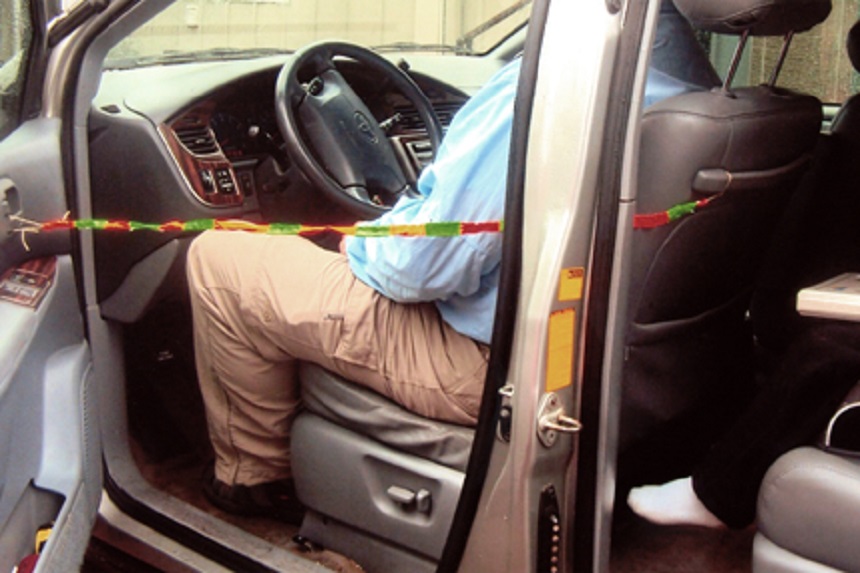A homemade bungee cord could save kids in hot cars
Andrew Pelham used duct tape and rubber bands to remind drivers of babies on board

The E-Z Baby Saver stops a driver from getting out of the car, and hopefully reminds them that there is a baby on board.
Meredith Pelham
Andrew Pelham, 12, is always inventing solutions to problems. He’s been doing it since he was five. That’s when his grandmother bought him his first set of LEGOs. Since then, the student at Meigs Magnet Middle School in Nashville, Tenn., has built inventions out of anything he could find. He’s taken up origami — the Japanese art of folding paper — to create boxes and barrels. Andrew also builds virtual worlds as he plays the computer game Minecraft. But sometimes, he’s found, all you need to invent something new are rubber bands and brightly-colored strips of duct tape.
Andrew’s system took home a second place prize in the 2013 Rubber Band Contest for Young Inventors. This summer, as temperatures rise and cars heat up, the inventor and his simple solution have been making headlines around the world. His design seems to help solve an important problem that he learned about last year: babies forgotten in the back seats of cars.
As sunlight comes in through the windows, a car’s seats and other surfaces absorb the energy and warm. The window glass traps this heat owing to something called the greenhouse effect. In summer, cars can heat up very quickly. Even when it’s only 22° Celsius (73° Fahrenheit) outside, in less than an hour the inside of a car sitting in the sun can heat up to 37 °C (100 °Fahrenheit). Sitting in a hot car can be very dangerous. Babies or pets can even die if adults forget and leave them behind.
“I heard a story on the news about a woman who left her child in a hot car,” he recalls. “The child died.” Andrew felt compelled to develop something to keep other parents from making the same horrible mistake.

He calls his solution E-Z Baby Saver. It’s something that anyone can make at home. You loop rubber bands together to create a long, flexible chain. Then cover the stretched-out chain with neon duct tape. The idea is to select a color that is sure to get a driver’s attention.
After getting into the car and closing the door, a driver just needs to attach one end of this homemade bungee to the back of the seat’s headrest and the other to the driver-side door handle. Now, when he or she attempts to open the door, the brightly-colored band stops the driver from getting out. Hopefully, this reminds the driver that there is a baby in the back seat.
Before settling on his eye-catching reminder, “I came up with a lot of different ideas,” Andrew says. “I thought of something with a flag that popped up or something that would attach to the baby in the car.” Once he decided on his E-Z Baby Saver, he had to test it. “I stuck my siblings in the car,” he recalls, “to see if it would make someone remember. And it did.”
Andrew has offers free instructions on his websiteabout how to build his E-Z Baby Saver. Of course, the invention is no more than a reminder. Parents still have to remember to use it. At the end of the trip, they also have to not make a habit of unhooking the cord without a thought. A reminder only works if people notice it. And while making the E-Z Baby Saver might be a fun project, any conventional bungee cord would probably serve the same purpose.
Andrew has no plans to stop inventing. He’s designed an origami rain barrel (with plastic-coated paper) for a local science fair. It could help people collect clean rainwater for drinking. He also designed an animal-proof camera enclosed in a plastic bottle for the National Geographic Engineering Exploration Challenge. The goal is to roll it up to an animal, allowing the photographer to get a close-up shot.
The 12-year-old is always getting inspiration for new inventions. “I just look around me and see what problems there are in the world,” he says. “Sometimes it’s kids in hot cars, or a need for clean water. But sometimes I’ll invent something to make my brother stop using the TV remote. Our world works around inventing.”
Follow Eureka! Lab on Twitter
Power Words
bungee cord An elastic cord — usually with a woven fabric covering — that has a large hook at either end. When stretched over or around objects and then hooked securely in place, this cord will keep objects from falling, slipping or coming loose.
greenhouse effect The warming of Earth’s atmosphere due to the buildup of heat-trapping gases, such as carbon dioxide and methane. Scientists refer to these pollutants as greenhouse gases. The greenhouse effect also can occur in smaller environments. For instance, when cars are left in the sun, the incoming sunlight turns to heat, becomes trapped inside and quickly can make the indoor temperature a health risk.
origami The traditional Japanese art of paper folding. It starts with a flat sheet of paper. Through folding — and no cutting — the paper can be fashioned into decorative 3-D structures, such as a bird in flight.







